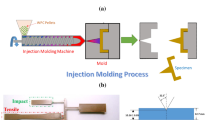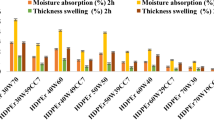Abstract
This paper presents a study on the potential use of high density polyethylene (HDPE) film as wood adhesive for formaldehyde-free plywood. The physical–mechanical properties of the plywood, including thickness swelling (TS), water absorption (WA), tensile shear strength, modulus of elasticity and modulus of rupture were evaluated. Results show that HDPE film dosage positively affects the properties when ranging from 61.6 to 246 g/m2. The performance of these panels was comparable to those of plywood made with commercial urea–formaldehyde (UF) resins. Comparisons of the dimensional stability between the two plywood demonstrated that 7-day TS and WA values of the panels bonded with UF resins were 5.10 and 23.5 % higher than those bonded with HDPE film, confirming the suitability of HDPE for the use as adhesive in wood-based composites intended for indoor applications subjected to high moisture. DMA tests show that HDPE bonded plywood was significantly inferior in thermal stability at 120 °C and above while it presented almost the same dynamic mechanical properties as UF plywood when the temperature was lower than 100 °C, making it suitable to be used as geothermal floor.
Zusammenfassung
In dieser Studie wird eine mögliche Verwendung von Hartpolyethylen-(HDPE) Folie als Klebstoff für die Herstellung von formaldehydfreiem Sperrholz untersucht. Die physikalisch-mechanischen Eigenschaften von Sperrholz, d.h. die Dickenquellung, die Wasseraufnahme, die Zugscherfestigkeit, der Elastizitätsmodul und die Biegefestigkeit wurden bestimmt. Die Ergebnisse zeigen, dass sich HDPE-Folie in einer Dosierungsmenge zwischen 61,6 und 246 g/m² positiv auf die Eigenschaften von Sperrholz auswirkt. Die Eigenschaften dieser Platten waren vergleichbar mit Sperrholz, das mit herkömmlichem Harnstoff-Formaldehydharz (UF) hergestellt wurde. Ein Vergleich der Dimensionsstabilität beider Sperrholzarten ergab, dass die 7-tägige Dickenquellung und die Wasseraufnahme bei den mit UF-Klebstoff gebundenen Platten um 5,10 bzw. 23,5 % höher waren als die entsprechenden Werte der mit HDPE gebundenen Platten, wodurch die Eignung von HTPE-Klebstoff für Holzwerkstoffe im Feuchtbereich bestätigt wurde. Eine Prüfung der dynamischen mechanischen Eigenschaften ergab, dass die Wärmebeständigkeit von mit HDPE gebundenem Sperrholz bei 120 °C und darüber signifikant niedriger als bei gebundenen Sperrholzplatten war, wohingegen sie bei Temperaturen unter 100 °C nahezu gleiche dynamische mechanische Eigenschaften aufwies. Damit können solche Platten bei Böden mit Fußbodenheizung verwendet werden.








Similar content being viewed by others
References
Aqmar AZ, ByungDae P (2010) Influence of acrylamide copolymerization of urea-formaldehyde resin adhesives to their chemical structure and performance. Appl Polym Sci 117:3181–3186
Ashori A, Nourbakhsh A (2009) Characteristics of wood-fiber plastic composites made of recycled materials. Waste Manage (Oxford) 29:1291–1295
Ayrilmis N, Kwon JH, Han TH (2012) Improving core bond strength and dimensional stability of particleboard using polymer powder in core layer. Compos B 43:3462–3466
Beg MDH, Pickering KL (2008) Reprocessing of wood fiber reinforced polypropylene composites. Part I: effects on physical and mechanical properties. Compos A 39:1091–1100
Bono A, Farm YY, Krishnaiah D, Ismail NM, Yee LYK, Lee LM (2010) Palm Kernel based wood adhesive. J Appl Sci 10:2638–2642
Desai SD, Patel JV, Sinha VK (2003) Polyurethane adhesive system from biomaterial-based polyol for bonding wood. Int J Adhes 23:393–399
Dias FM, Rocco LFA (2004) Alternative castor oil-based polyurethane adhesive used in the production of plywood. Mater Res 7:413–420
Faruk O, Matuana LM (2008) Nanoclay reinforced HDPE as a matrix for wood-plastic composites. Compos Sci Technol 68:2073–2077
Frihart CR (2005) Wood adhesion and adhesives. In: Rowell RM (ed) Handbook of wood Chemistry and Wood Composites. CRC, Florida, p 225
GB/T 17657 (1999) Test methods of evaluating the properties of wood-based panels and surface decorated wood-based panels. Chinese National Committee for standardization
GB/T 9846.7 (2004) Plywood-Part 7: cutting of test specimens. Chinese National Committee for standardization
GB/T 9846.3 (2004) Plywood-part 3: General specification for plywood for general use. Chinese National Committee for standardization
International Agency for Research on Cancer; World Health Organization (2004) IARC classifies formaldehyde as carcinogenic to humans, http://www.iarc.fr/ENG/Press-Releases/archives/pr153a.html. Accessed 21 March 2008
Jang Y, Huang J, Li KC (2011) A new formaldehyde-free wood adhesive from renewable materials. Int J Adhes 31:754–759
Jin YQ, Cheng XS, Zheng ZB (2010) Preparation and characterization of phenol-formaldehyde adhesives modified with enzymatic hydrolysis lignin. Bioresour Technol 101:2046–2048
Kaboorani A, Faezipour M, Earahimi G (2008) Feasibility of using heat treated wood in wood/thermoplastic composites. J Reinf Plast Compos 27(16–17):1689–1699
Kelley SS, Rials TG, Glasser WG (1987) Relaxation behavior of the amorphous components of wood. J Mater Sci 22:617–624
Moubarik A, Pizzi A, Allal A, Charrier F, Charrier B (2009) Cornstarch and tannin in phenol-formaldehyde resins for plywood production. Ind Crops Prod 30:188–193
Moubarik A, Allal A, Pizzi A, Charrier F, Charrier B (2010) Characterization of a formaldehyde-free cornstarch-tannin wood adhesive for interior plywood. Eur J Wood Prod 68:427–433
Ozalp M (2011) Study of the effect of adding the powder of waste PET bottles and borax pentahydrate to the urea formaldehyde adhesive applied on plywood. Wood Prod 69:369–374
Qi CS, Guo KQ, Liu YY (2012) Preparation and properties of cotton stalk bundles and high-density polyethylene composites using hot-press molding. J Reinf Plast Compos 31(15):1017–1024
Sellers TJ (2001) Wood adhesive innovations and applications in North America. For Prod 51:12–22
Tang L, Zhang ZG, Qi J, Zhao JR, Feng Y (2011) The preparation and application of a new formaldehyde-free adhesive for plywood. Int J Adhes 31:507–512
Tang L, Zhang ZG, Qi J, Zhao JR, Feng Y (2012) A new formaldehyde-free adhesive for plywood made by in situ chlorinating grafting of MAH onto HDPE. Eur J Wood Prod 70:377–379
YongSung O, KyungHee K (2011) Evaluation of Melamine-modified Urea-Formaldehyde Resin for Plywood Flooring Adhesive Application. Sci For 39:199–203
Acknowledgments
This work was supported by the special scientific research of the forest public welfare industry [grant number 201004004].
Author information
Authors and Affiliations
Corresponding author
Rights and permissions
About this article
Cite this article
Fang, L., Chang, L., Guo, Wj. et al. Preparation and characterization of wood-plastic plywood bonded with high density polyethylene film. Eur. J. Wood Prod. 71, 739–746 (2013). https://doi.org/10.1007/s00107-013-0733-0
Received:
Published:
Issue Date:
DOI: https://doi.org/10.1007/s00107-013-0733-0




